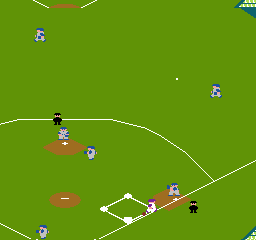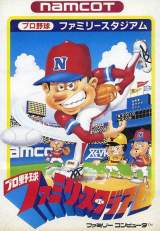
Pro Yakyuu Family Stadium © 1986 NAMCOT.

BARCODE: 4907892000223
Pro Yakyuu Family Stadium was released on December 10, 1986 in Japan.
Toy Pop was the first game of its director, who didn’t have much experience and the development of the game didn’t progress very fast. Kishimoto was also working on Toy Pop, but sometimes he didn’t have much to do at his workplace and spent his free time playing Baseball (Famicom), Great Baseball (Mark III) and other baseball games (including one game released on Intellivision) with his boss (Nagashima). He complained about what was missing in these games and his boss then told him that he should develop his own baseball game.
After the development of Toy Pop was finished, Kishimoto went back to Nagashima to make this game. The decision to develop it on Famicom was made naturally because of the popularity of the console.
In addition to the programming part, Kishimoto had designed almost all the graphics and the logo of the game, which was originally called Fine Play. His boss told him to change its name to Family Stadium because Namco had started a line of games called “Family something” (Family Tennis, etc.) for 2 player games.
The first Family Stadium was developed in almost 6 months by the Pikkari team, founded on May 10, 1986. The game was directed by Hiro who had worked on Family Tennis before that. The team scouted the Kawasaki stadium because Kishimoto was having trouble animating the batters from behind. He was the one who paid for the tickets for the matches. He was inspired by what he saw to create the players’ statistics.
The Computer Vs Computer mode amused the developers and allowed them to spot bugs. One of them suggested that this mode be kept in the final version.
During the development of the game, more and more Namco members came to play it. An internal tournament was organized but the shouting of the players bothered the developers around them. The management then forbade to play Family Stadium in their workplace.
The game was first released as an arcade game on Nintendo’s VS System before being released on Famicom a week later. A bug related to the VS System hardware caused the game to stop during the game. As it was impossible to correct this issue on all the systems, Nintendo asked Namco to add a message that appears when the bug occurs. The message in question said that "the game was interrupted due to rain".
The Famicom version quickly sold out, with an initial run of 300,000 units (which wasn’t huge). It is said to have sold nearly 1.1 million in total.
Kishimoto received a diploma from Namco’s president Masaya Nakamura (who wrote it in his own handwriting), to thank him for his contribution to the prosperity of the company, as well as an envelope of 1 million yen in cash. It seems that Kishimoto was the first employee of Namco to receive such a diploma. His boss Nagashima as well as his colleagues didn’t receive one so he shared his envelope with them.
Export releases:
[US] "R.B.I. Baseball [Model NES-RS-USA]", Kishimoto worked on this US version. To change the names of the players, a planner from Atari came.
* Credits screen:
Play exactly 10 games, no matter if you win or lose. It can even be the games played in WATCH mode by the computer itself. After the 10th game is over and the game returns to the title screen, a credits screen will appear before the team names demonstration.
* Debug monitor:
At any time during the game, hold Up + Down on controller 1, then press Right, Left, Down, Up on controller 2.
A set of numbers will appear at the top-right corner of the screen. The upper four represents the address, and the bottom two are data value at the selected address. Press B on controller 2 to enable address and data edit: change any digit using the D-Pad buttons on controller 2, or press the previous combination to save your changes. You can watch any ROM or RAM data and change any RAM data.
Head: Hiro
Game Design & Program: Yoshihiro Kishimoto (Kissy)
Graphic: Hie
Advices: F.S. Freaks
CRC Text Routine by: Haruhisa Udagawa, Kumi Hanaoka
Game's ROM.